Effective Debt Management Strategies For SMEs – Complete Guide

In today’s ever-evolving global economic landscape, small and medium-sized enterprises (SMEs) face a myriad of challenges that can significantly impact their sustainability and growth. The importance of effective debt management strategies cannot be overstated, especially considering the recent global economic turbulence and the ongoing adjustments from the COVID-19 pandemic. As Steve Johnston, drawing from my extensive experience in digital transformation and financial management, I’ve seen firsthand how crucial managing debt is for SMEs to navigate these uncertain times successfully. A report by the World Economic Forum in December 2022 highlighted that 67% of SMEs worldwide are fighting for survival amid warnings of a global recession. This statistic underscores the vital role that debt management plays in ensuring the continuity and growth of these businesses. Furthermore, the IMF’s World Economic Outlook Update for January 2024 indicates a projected global growth of 3.1 percent in 2024, with risks to global growth being broadly balanced. The update emphasizes the potential for a soft landing, given current economic conditions, including moderating inflation and steady growth. These insights provide a backdrop against which SMEs must strategize their debt management to align with the global economic rhythm. Understanding Your Debt Situation The first step in effective debt management is accurately assessing your debt situation. This involves identifying various types of debts your business may have, such as short-term vs. long-term debts and secured vs. unsecured debts. It’s crucial to understand the nature of each debt to prioritize them effectively. Drawing from my experience, I recommend SMEs conduct a thorough audit of their debts, categorizing them by urgency and impact on the business. This approach is not just about numbers; it’s about understanding the implications of each debt type on your business’s financial health and operations. Developing A Comprehensive Debt Management Plan Developing a comprehensive debt management plan is an iterative process that involves setting realistic debt reduction goals and prioritizing debts. It’s essential to integrate real-life scenarios and examples from managing SME finances to create a robust plan. For instance, negotiating more favorable terms with creditors can provide immediate relief and contribute to long-term financial stability. Debt consolidation and refinancing are also effective debt management strategies that can help SMEs streamline their financial obligations, potentially reducing monthly costs and easing cash flow issues. From my personal experience working with SMEs, one of the key strategies has been to focus on maintaining a healthy cash flow by managing debt smartly. This includes consolidating multiple loans into one with a lower interest rate, thus reducing monthly payments and freeing up cash for other critical business needs. Additionally, prioritizing high-interest debts for payment can significantly cut costs and improve the financial position of the business. Strategy Impact on Cash Flow Impact on Financial Health Debt Consolidation Improves by streamlining payments Enhances by reducing interest costs Prioritizing High-Interest Debts May temporarily strain but improves long-term stability Significantly improves by cutting costly debts Renegotiating Terms Can improve if terms extend or costs lower Improves by potentially lowering costs How Debt Consolidation Benefits SMEs Debt consolidation is a key strategy for small and medium-sized enterprises (SMEs) aiming to improve their financial health. By combining multiple debts into one loan with a lower interest rate, SMEs can achieve a healthier cash flow. This method simplifies monthly payments, making financial management more straightforward and freeing up resources that can be redirected towards growth and operational needs. For a small business owner juggling various debts, including business loans and credit card debt, consolidation offers a way to reduce monthly costs and manage debt more effectively. It allows for better cash flow management by ensuring that outgoing costs are predictable and more manageable. This strategic approach not only helps in managing existing debts but also contributes to the overall financial position of the business, making it a critical component of effective debt management for SMEs. Strategies For Managing And Reducing Debts Expense Management Techniques Managing expenses is crucial for SMEs, especially in times of financial strain. While it’s tempting to cut costs wherever possible, it’s essential to do so without compromising the integrity and quality of your business. For example, evaluating and trimming unnecessary overheads can free up funds without affecting core operations. This might include renegotiating contracts for services like internet or utilities or finding more cost-effective suppliers without sacrificing quality. Revenue Enhancement Strategies Boosting sales and exploring new markets are key strategies I’ve used successfully in my business ventures. Here are a few tactics that have worked: These strategies not only increase revenue but also build a stronger, more resilient business model capable of withstanding financial pressures. Cash Flow Management Cash flow is the lifeblood of any SME. Statistics have shown that a significant number of businesses face challenges due to poor cash flow management, with 25% of SMEs being turned down for funding because of poor earnings and cash flow. Managing cash flow effectively involves several key strategies: Implementing these strategies can help maintain a healthy cash flow, which is crucial for meeting ongoing financial obligations and supporting growth initiatives. Engaging With Stakeholders Maintaining transparent communication with creditors, suppliers, and customers is essential for managing debt and sustaining business operations. Here are some practical steps based on my experiences: These practices not only help in managing debt more effectively but also strengthen relationships with key stakeholders, creating a supportive ecosystem for your business. Interest Rate Tactics For SMEs Interest rates play a significant role in the cost of debt for SMEs. Managing these rates effectively can lead to significant savings and contribute to financial stability. SMEs should prioritize securing loans with the lowest possible interest rates, whether through negotiating better terms with current lenders or refinancing high-interest debts. Understanding the implications of both fixed and variable interest rates is crucial, as is choosing the right type based on the business’s cash flow and financial outlook. Additionally, small business owners can explore secured debts, which often come with lower interest rates due to the collateral involved. Financial advisors can provide valuable insights into
The 5 Principles Of Risk Management – SteveOnDigital

The 5 principles of risk management serve as the cornerstone for effectively identifying, assessing, and mitigating risks within an organization. These principles are; 1) Risk Identification, where potential threats are recognized; 2) Risk Analysis, to understand the nature and impact of these risks; 3) Risk Evaluation and Prioritization, which helps determine which risks require immediate attention; 4) Risk Mitigation, involving strategies to minimize the impact of risks; and 5) Continuous Monitoring, to ensure that risk management strategies are effective and adapt to new threats. Together, these principles provide a structured approach to managing uncertainties, enabling organizations to achieve their objectives while minimizing potential negative impacts. One compelling example of the evolving risk landscape is the increasing importance of climate risk and ESG (Environmental, Social, and Governance) considerations in credit portfolio management. A McKinsey survey highlighted that 86% of participants identified climate and ESG risks as significant challenges for the next two to three years. This underscores the importance of integrating risk management into the strategic planning and operational processes of businesses. Crafting Your Risk Management Framework In the realm of digital transformation and business strategy, establishing a robust Risk Management Framework is non-negotiable. It’s the bedrock upon which organizations can navigate the unpredictable waters of operational, financial, and strategic risks. Principle 1: Risk Identification Risk identification is the initial step in the risk management process, where businesses identify potential risks that could impact their operations. This involves using various techniques and tools such as Bowtie Analysis, Fault Tree Analysis (FTA), and Event Tree Analysis (ETA) to systematically identify risks. From my past projects, employing these tools has provided invaluable insights into potential threats, enabling us to devise robust strategies to mitigate them effectively. Principle 2: Risk Analysis Following risk identification, the next step is risk analysis, which assesses the nature and extent of the risk. This can be done through qualitative and quantitative methods, providing a comprehensive understanding of each risk’s impact. For instance, quantitative risk analysis might include using Monte Carlo Simulation to predict the probability of different outcomes under uncertainty. Incorporating data analytics into risk management can significantly enhance the process. For example, leveraging big data allows for the identification of emerging risks by analyzing vast amounts of internal and external data. This approach has been instrumental in my experience, enabling us to predict potential issues before they materialize. Principle 3: Risk Evaluation And Prioritization In my journey as an entrepreneur, I’ve learned the critical importance of evaluating and prioritizing risks within any project or business venture. Risk evaluation involves assessing the potential impact and likelihood of identified risks, ensuring a strategic approach to managing what threatens our objectives. Understanding Risk Evaluation Risk evaluation allows us to weigh the consequences of risks against our project goals or business objectives. This process is crucial for distinguishing between minor setbacks and critical threats, ensuring resources are allocated effectively. Techniques For Risk Scoring And Ranking Using techniques such as risk matrices and scoring systems, we can rank risks by their severity and likelihood. These tools help in visualizing risks, making it easier for teams to understand and prioritize them. In my experience, applying these techniques has enabled more informed decision-making and focused risk mitigation strategies. Introduction To Risk Assessment Matrix A Risk Assessment Matrix is a tool I’ve used extensively to categorize risks. It plots the likelihood of a risk occurring against its potential impact, helping to prioritize risks based on a color-coded system. This visual representation is invaluable for communicating risk priorities to stakeholders. Risk Likelihood Minor Impact Moderate Impact Major Impact Very Likely Green Yellow Red Likely Green Yellow Orange Unlikely Green Green Yellow Risk Acceptability Criteria Setting clear risk acceptability criteria is vital. It defines the thresholds for what is considered an acceptable or unacceptable level of risk, guiding decision-making processes and ensuring consistency in how risks are treated across the organization. Prioritization Of Risks For Effective Management Prioritizing risks involves distinguishing which risks need immediate attention and which can be monitored over time. This step is crucial for resource allocation, focusing efforts on preventing or mitigating the most significant risks first. Principle 4: Risk Control And Mitigation Strategies For Risk Control And Mitigation Effective risk management requires a blend of strategies tailored to the specific risks and the industry context. For instance, in the Oil and Gas industry, risk control might include rigorous safety protocols and environmental impact assessments. Risk Control Techniques From my past projects, utilizing a combination of these techniques has been crucial in managing the inherent risks effectively. Principle 5: Risk Monitoring And Review Continuous Process Of Monitoring And Reviewing Risks An ongoing process of risk monitoring and review is essential for adapting to new information or changes in the external environment. This involves regular assessments to ensure risk management strategies remain effective and relevant. Role Of Stakeholders In The Risk Review Cycle Engaging stakeholders in the risk review process ensures a broader perspective, fostering a culture of transparency and collective responsibility for risk management. Their insights can be invaluable for identifying new risks or reassessing existing ones. Importance Of A Dynamic And Adaptive Risk Management Process The dynamic nature of risks, especially with emerging challenges like climate change and digital transformation, requires an adaptive risk management process. This flexibility has been crucial in navigating uncertainties in my ventures, allowing for rapid adjustments to strategies as conditions change. Examples Of Effective Risk Monitoring Effective risk monitoring can be seen in businesses that proactively adjust their risk management approaches in response to emerging threats or opportunities. For example, adapting cybersecurity measures in response to new types of cyber threats demonstrates an effective risk monitoring and adaptation process. Implementing Risk Management Implementing a robust risk management process is critical for any organization aiming to navigate the complexities of today’s business environment effectively. Drawing from my extensive experience and the latest industry insights, I’ve outlined the fundamental steps and considerations for establishing a comprehensive risk management plan. Steps Of The Risk Management Process Identifying Risks: The
What Are The 5 Stages Of Innovation?

The five stages of innovation form a roadmap for turning a simple idea into a successful innovation. They are: 1) Ideation and Knowledge Gathering, where the journey begins with brainstorming and researching; 2) Evaluation and Advocacy, assessing the idea’s viability and gaining support; 3) Experimentation and Decision Making, testing the idea and making key decisions; 4) Implementation and Commercialization, bringing the idea to life and introducing it to the market; and 5) Growth and Sustainability, scaling the innovation and ensuring its long-term impact. This straightforward guide aims to demystify the innovation process, making it understandable and actionable for anyone looking to bring new ideas to fruition. Stage of Innovation Key Activities 1. Ideation and Knowledge Gathering – Advanced idea generation techniques – Mobilizing ideas into action – Harnessing intellectual property 2. Evaluation and Advocacy – Screening ideas with precision – Innovation advocacy and stakeholder engagement – Preparing the organization for innovation 3. Experimentation and Decision Making – Prototyping and real-world testing – Establishing feedback loops – Critical decision-making points 4. Implementation and Commercialization – Pilot projects and full-scale launch – Marketing and sales strategies – Quality control and supply chain management 5. Growth and Sustainability – Sustainable innovation practices – Scaling innovations globally – Learning from failure and continuous improvement Innovation Process In navigating the innovation process, we aim to achieve innovation progress through a structured journey, starting with idea generation and culminating in the successful launch of new innovations. This journey is marked by the five stages of innovation, each critical for transforming ideas into impactful solutions. The innovation process is inherently iterative, relying heavily on customer feedback and the continuous refinement of new ideas. A framework offers practical guidance, ensuring that even a few innovative individuals can make a substantial impact. By embedding an innovation culture and fostering basic innovation behavior, organizations can create an environment where innovation flourishes, guided by valuable insights and a strategic business strategy. The Evolution Of Innovation Historically, innovation has been the catalyst for change, driving societal progress and transforming the way we live and work. From the steam engine propelling the Industrial Revolution to the digital revolution reshaping every aspect of our lives, each milestone in innovation has been a testament to human ingenuity and determination. In my own experiences, leading innovation projects and fostering a culture of creativity within organizations, I’ve seen how these historical milestones continue to influence business practices and societal norms. Defining Innovation In The 21st Century Today, innovation transcends traditional boundaries. It encompasses technological advancements, social changes, and process improvements, all converging to address the complexities of a rapidly evolving world. My work in innovation engineering and managing strategic projects has shown me the power of harnessing this multifaceted nature of innovation to drive successful outcomes and create meaningful change. Why Understanding Innovation Stages Is Crucial Grasping the intricacies of the innovation process is crucial for anyone looking to make a mark in their field. It’s about more than just generating ideas; it’s about systematically transforming those ideas into reality, navigating the challenges of the market, and ultimately achieving a competitive edge. Drawing from my experience, understanding these stages has been pivotal in improving success rates, fostering competitive advantage, and ensuring that innovations have a positive societal impact. I. Ideation And Knowledge Gathering Beyond Brainstorming Idea generation is the bedrock of innovation. Yet, it goes beyond mere brainstorming sessions. Techniques like design thinking, open innovation challenges, and leveraging AI for creative processes have been central to my approach. These methods not only generate ideas but also ensure that they are diverse, feasible, and aligned with market needs. Mobilizing Ideas Into Action Transforming ideas into actionable innovation projects requires a supportive ecosystem. My engagement with innovation labs, incubators, and accelerators has taught me the value of providing ideas with the resources and environment they need to flourish. The Knowledge Economy In today’s knowledge economy, information is a powerful asset. My strategy has always involved harnessing intellectual property, tapping into academic research, and gathering market insights to inform and guide innovation efforts. Building An Innovation Ecosystem Creating an environment that nurtures innovation involves fostering collaboration across startups, corporations, and academic institutions. This ecosystem approach has been fundamental to my work, enabling the cross-pollination of ideas and resources necessary for innovation to thrive. II. Evaluation And Advocacy Screening Ideas With Precision Evaluating the potential of ideas is a delicate balance of art and science. Tools like SWOT analysis, feasibility studies, and market analysis have been instrumental in my toolkit, allowing me to screen ideas with precision and identify those with the greatest potential. The Art Of Innovation Advocacy Gaining support for innovation projects is as much about advocacy as it is about the idea itself. I’ve learned the importance of crafting compelling pitches and leveraging success stories to build stakeholder buy-in and secure the necessary resources. From Preparation To Action Preparing an organization for innovation is a multifaceted challenge. It involves not just setting up the right teams and processes but also cultivating an innovation-friendly culture. My experiences have underscored the importance of aligning human talent with innovation goals and embedding an innovation culture within the organization. Risk And Reward Innovation is inherently risky, but the potential rewards are significant. Balancing these risks and rewards—considering financial, operational, and reputational factors—has been a critical aspect of my approach to innovation. III. Experimentation And Decision Making Prototyping The Future Prototyping is a powerful tool for bringing ideas to life, allowing for real-world testing and iteration. My approach has involved using various prototyping methods to validate ideas and engage users, ensuring that innovations meet market needs and preferences. Feedback Loops And Learning Establishing effective feedback mechanisms is crucial for refining innovations. My strategy has included leveraging customer feedback, beta testing, and iterative development to continuously improve and adapt innovation projects. The Decision Crossroads The innovation process is punctuated by critical decision points—whether to scale up, pivot, or sunset a project. My experiences have taught me the importance of making these decisions based
7 Sources Of Innovation – Everything You Need To Know

In today’s fast-changing business world, being innovative is key to staying ahead. I’m Steve Johnston, and I’ve learned a lot about innovation from my work in engineering, business, and digital transformation. There’s a great idea called the “seven sources of innovation” that helps businesses find new opportunities. This idea tells us that to be successful, companies need to look for chances to improve and lead, not just follow the market. By understanding and using these seven sources, businesses can grow and set new trends. Source of Innovation Description Example The Unexpected Innovations stemming from unexpected events or results. A pharmaceutical company discovering a new drug application during trials for a different condition. The Incongruity Innovation from the mismatch between reality and assumptions. Tech companies developing products for emerging markets that defy traditional consumer profiles. Process Need Innovations that address inefficiencies or gaps in processes. Automating manual, time-consuming tasks in data analysis with AI. Industry & Market Structure Changes Innovations prompted by shifts in the market or industry. E-commerce platforms expanding into new markets due to increased online shopping demand. Demographics Innovations driven by changes in population dynamics. Developing aging-friendly tech products as the global population ages. Changes in Perception Innovations arising from new ways people view their world. Sustainable products gaining popularity as environmental awareness increases. New Knowledge Innovations based on scientific discoveries or new understandings. Biotech firms leveraging CRISPR technology for gene editing. The Unexpected In the world of business and innovation, the unexpected isn’t just a surprise—it’s an opportunity. Unexpected events, whether they are successes, failures, or completely out of the blue, have the power to open doors to innovation that we might never have considered otherwise. My name is Steve Johnston, and in my journey as a Digital Transformation Specialist, I’ve witnessed firsthand how these unforeseen moments can lead to groundbreaking innovative ideas. One such instance occurred in the early stages of a startup I was advising. An unexpected shift in the market structure, initially perceived as a setback, unveiled a unique innovative opportunity. By analyzing this unexpected change, we discovered a niche that was previously underserved. This revelation led to the development of a product that not only catered to this new market but also set a benchmark for innovation within the industry. Leveraging The Unexpected The Incongruity Incongruity, the mismatch between reality and our assumptions or expectations, often reveals significant opportunities for innovation. Steve Johnston, a pioneer in modern management thought, emphasized the importance of identifying and exploiting these discrepancies. In the digital era, where industry and market structure are in constant flux, recognizing incongruities has become more crucial than ever. From my experience, one of the most common forms of incongruity occurs when there’s a disparity between the actual uses of a product and the ways in which it was intended to be used. This was evident when a software tool we developed for internal project management was unexpectedly embraced by our clients as a collaborative platform. This incongruity between our perception of the product and its actual application in the market led us to pivot our strategy, expanding our product lines to cater to this newfound demand. Strategies To Identify And Exploit Incongruity Innovation Based On Process Need In our continuous quest for improvement and efficiency, innovation often stems from a critical examination of our processes. As a Digital Transformation Specialist, I’ve seen firsthand how addressing process needs can lead to significant innovation, driving systematic innovation and embodying the principles of modern management. Process Need Innovation Case Studies Implementing Process Innovation Changes In Industry Or Market Structure The landscape of industry and market structure is ever-evolving, driven by changes in technology, consumer behavior, and regulatory environments. Understanding and adapting to these changes is key to staying ahead. Market Dynamics Spotting The Change Adapting To Change Demographics In the realm of innovation, understanding demographic trends is not just about knowing your audience but foreseeing the future of consumer demand. As Steve Johnston, I’ve navigated the complex landscape of industry and market structure changes, learning that demographic data serves as one of the most reliable indicators for spotting innovative opportunities. Demographic Trends Analyzing Demographic Data For Innovation Businesses must adopt a data-driven approach to understand these demographic shifts. Using tools to analyze demographic data enables businesses to predict market trends and identify areas ripe for innovation. For example, by analyzing demographic changes, my team and I were able to identify a growing interest in sustainable living among younger generations, leading us to develop eco-friendly product lines that have since become a cornerstone of our business model. Demographic-Driven Innovation Tailoring products and services to meet the evolving needs of different demographic groups is crucial. This could mean developing new products for an aging population, adapting marketing strategies to appeal to Generation Z’s values, or leveraging technology to enhance accessibility for people with disabilities. Changes In Perception, Mood, And Meaning Perception shapes reality, especially in the consumer market. Shifts in societal mood, perception, and the underlying meaning people assign to life and products can dramatically alter the innovation landscape. Perception’s Role In Innovation Identifying Shifts In Perception Staying attuned to these shifts requires businesses to be actively engaged with their audience through social media, market research, and direct feedback mechanisms. As someone who has been at the forefront of digital transformation, I’ve leveraged these platforms not just to listen but to engage in meaningful dialogues with consumers, gaining valuable insights into their evolving needs and perceptions. Capitalizing On Perception Change New Knowledge In today’s rapidly evolving business landscape, staying ahead means not just adapting to changes but anticipating them. As Steve Johnston, my journey through the digital transformation landscape has taught me the critical role of new knowledge — both scientific and non-scientific — in fostering innovation. Here’s how businesses can harness this invaluable resource. The Power Of Knowledge Knowledge is the cornerstone of innovation. It transforms industries, reshapes market structures, and redefines what is possible. From the latest advancements in AI to understanding shifts in
Role Of Innovation In Entrepreneurship – SteveOnDigital
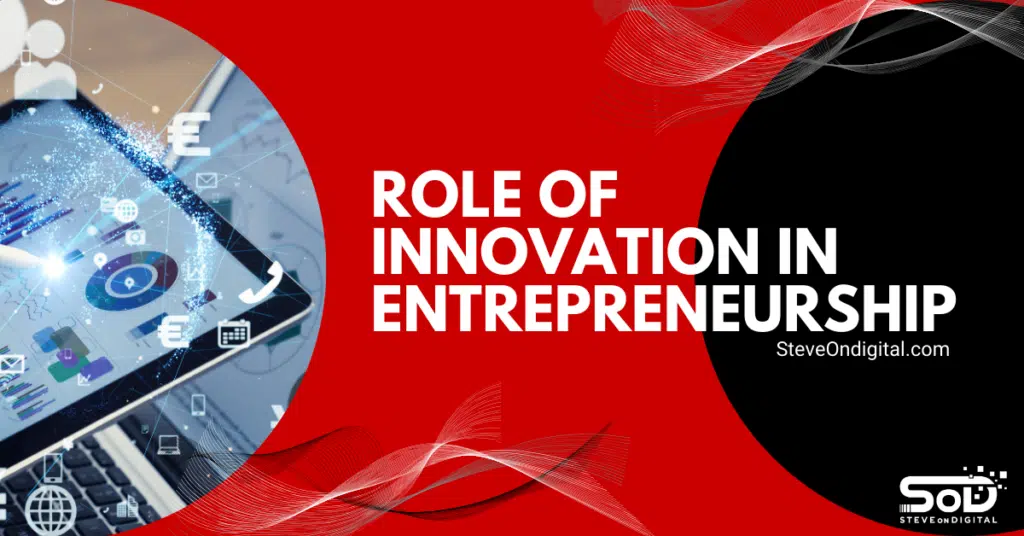
In the ever-evolving world of entrepreneurship, innovation stands as a beacon of progress, guiding businesses towards success and sustainability. As Steve Johnston, a seasoned expert in digital transformation for SMEs, I’ve witnessed firsthand the transformative power of innovation in reshaping industries and propelling businesses into new realms of possibilities. This blog post delves into the essence of innovation in entrepreneurship, highlighting its significance for entrepreneurs and businesses striving to make their mark in a competitive landscape. Innovation in entrepreneurship isn’t just about introducing new products or services; it’s a comprehensive approach that encompasses reimagining business models, refining processes, and adopting emerging technologies to meet and exceed market demands. It’s the lifeblood of entrepreneurial ventures, driving economic growth, fostering competitive advantage, and enhancing customer loyalty through creative development and innovative solutions. The significance of innovation extends beyond mere survival in the business world. It represents the key to unlocking new markets, achieving long-term success, and creating a legacy that transcends the boundaries of existing markets. For entrepreneurs, innovation is not an option but a necessity, a crucial driver of entrepreneurial success that demands a continuous commitment to creative thinking, risk-taking, and strategic foresight. Section 1: Understanding Innovation In Entrepreneurship Definition And Dimensions Of Innovation Innovation, in its broadest sense, refers to the process of introducing something new or improving something existing, whether it’s a product, service, or a way of doing business. However, it encompasses much more than mere novelty; it involves a series of systematic, strategic steps designed to bring about significant, positive change. Innovation in entrepreneurship is characterized by its ability to challenge the status quo, offering innovative solutions that meet emerging trends and market demands. Types Of Innovation: Disruptive, Incremental, Radical, And Architectural Distinction Between Innovation And Invention While innovation and invention are closely linked, they are not interchangeable. Invention is the creation of a new idea or concept, the spark that ignites the potential for change. Innovation, on the other hand, is the practical application of these inventions or new ideas, transforming them into tangible, marketable solutions that address specific customer needs and business strategies. It’s about taking the leap from theoretical to practical, from idea to impact. Section 2: The Catalysts Of Entrepreneurial Innovation In my journey as the founder of SteveOnDigital, I’ve seen firsthand how innovative ideas act as the backbone of industry transformation. Innovation isn’t just about newness; it’s about making changes that add value, fundamentally altering how we perceive and interact with the world around us. Let’s dive into the catalysts that drive entrepreneurial innovation and, subsequently, reshape entire industries. Role Of Innovative Ideas In Shaping Industries Innovative ideas have the power to disrupt traditional business models, paving the way for new markets and opportunities. Take, for example, how disruptive innovation has led to the rise of the sharing economy. Platforms like Airbnb and Uber didn’t just offer new services; they changed how we think about accommodation and transportation, challenging established sectors to adapt or face obsolescence. This kind of innovation underscores the importance of entrepreneurial ventures in not just participating in the market but actively reshaping it. Exploring Innovative Solutions And Their Impact On Business Success The implementation of innovative solutions is critical for achieving business success. These solutions often stem from identifying market gaps and leveraging emerging technologies to address them. As a digital transformation specialist, I’ve helped SMEs introduce innovative products that significantly enhance their competitive advantage. Whether it’s through innovative projects that streamline operations or innovative strategies that redefine customer engagement, the result is a marked improvement in economic growth and customer loyalty. Importance Of Adopting New Business Models In Response To Market Trends Staying relevant in today’s fast-paced world means being agile and responsive to market trends. New business models are not just about innovation for its own sake but about survival and sustainability. For instance, the subscription model, popularized by companies like Netflix, has now been adopted across industries from software to food delivery. This shift was not just about offering something new but about aligning business operations with changing consumer preferences and market dynamics. Section 3: Innovation’s Influence On Market Dynamics Innovation doesn’t just change businesses; it changes the market itself. Here’s how entrepreneurship innovation plays a crucial role in this dynamic. Analyzing Entrepreneurship Innovation In Adapting To Market Gaps Market gaps offer a clear signal for where innovation can take root. My experience in digital transformation has shown me that businesses that can identify and fill these gaps not only secure their place in the market but often redefine it. Entrepreneurial innovation involves using innovative ideas to address unmet needs, leading to the development of innovative products and services that can capture new markets. How Innovative Culture Fosters Competitive Advantage An innovative culture is foundational to maintaining a competitive edge. It encourages continuous creative thinking and risk-taking, essential for business growth and long-term success. In my role, fostering a culture where innovative efforts are celebrated and where failure is seen as a step towards learning has been pivotal in nurturing successful businesses. This culture is what enables companies to stay ahead of the competitive landscape, turning challenges into opportunities for innovation. The Significance Of Creative Development In Innovation Creative development in innovation isn’t just about creating new products; it’s about rethinking existing processes and finding ways to enhance customer experiences. This process is integral to innovative businesses, as it leads to enhanced customer experiences and builds customer loyalty. By integrating customer feedback into the innovation process, businesses can ensure their innovations are not only novel but also deeply relevant and valuable to their target audience. Section 4: From Ideas To Implementation The journey from innovative ideas to their successful implementation is both exhilarating and daunting. As the founder of SteveOnDigital, I’ve navigated this path multiple times, transforming visions into tangible outcomes that drive business growth and entrepreneurial success. Process Of Transforming Innovative Ideas Into Successful Ventures Transforming an innovative idea into a successful venture involves several key stages: Throughout these stages, maintaining an innovative
Growth Mindset in Business: Drive Innovation And Collaboration
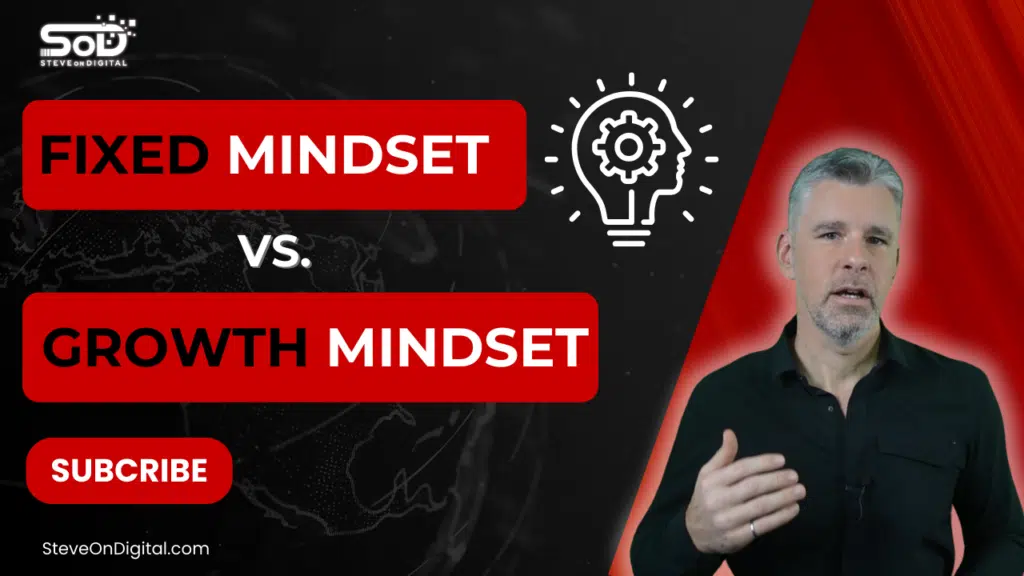
A growth mindset in business means believing that abilities and intelligence can improve through effort and learning. This approach fosters innovation, adaptability, and long-term success by encouraging continuous learning and improvement. Carol Dweck’s decades of research on growth mindset have shown how this approach can significantly influence organizational culture, leading to innovation and collaboration in the workplace. I’ve seen firsthand how adopting a growth mindset can transform a business. By focusing on challenges as opportunities, fostering team development, and promoting a culture of continuous improvement, businesses can stay competitive in a rapidly changing market. Let’s explore how this powerful mindset can drive success and innovation in your organization. I’m Steve, a digital transformation expert with a strong background in electrical engineering, an MBA, and a master’s in Project Management. I excel at helping SMEs navigate the digital landscape with practical insights. Let’s begin! Understanding Growth Mindset in Business A growth mindset in business is essential for fostering innovation, adaptability, and long-term success. By focusing on continuous learning and improvement, businesses can navigate challenges more effectively and stay competitive in a rapidly changing market. Definition and Origin of Growth Mindset The concept of a growth mindset originates from the work of Stanford University psychology professor Carol Dweck. She defined it as the belief that abilities and intelligence can be developed through dedication and hard work. This contrasts with a fixed mindset, where individuals believe their talents are innate and unchangeable. Growth Mindset vs. Fixed Mindset A growth mindset believes that intelligence and skills can improve with effort and persistence. In contrast, a fixed mindset believes that abilities and intelligence are static and unchangeable, which may hinder an individual’s potential. This fundamental difference impacts how individuals approach challenges and learning opportunities. Those with a growth mindset are more likely to embrace new challenges and view failures as opportunities to grow, whereas those with a fixed mindset may avoid challenges for fear of failure. Aspect Growth Mindset Fixed Mindset Belief Abilities can be developed Abilities are static and unchangeable View on Challenges Embraces challenges as opportunities to grow Avoids challenges due to fear of failure Response to Failure Sees failure as a learning opportunity Sees failure as a limit to abilities Effort Believes effort is essential for mastery Believes effort is fruitless if one lacks talent Learning Continuous learning and improvement are valued Avoids new learning opportunities The Role of Growth Mindset in Business Success Adopting a growth mindset can lead to significant long-term benefits for businesses. A growth mindset views intelligence, abilities, and talents as qualities that can be developed through effort and persistence. Companies that encourage a growth mindset often see increased innovation, better team development, and improved employee performance. By fostering an environment where continuous learning and improvement are valued, businesses can better adapt to changes and overcome obstacles. Key Characteristics of Growth Mindset Several traits define a growth mindset, making it a critical aspect of business success. Characteristic Description Embracing Challenges Views challenges as opportunities for growth and learning Effort and Persistence Recognizes that hard work and dedication are essential for success Learning from Mistakes Understands that mistakes are valuable learning opportunities Continuous Improvement Focuses on ongoing development and betterment Open to Feedback Welcomes feedback and uses it to improve Embracing Challenges A growth mindset views challenges as opportunities for growth and learning. In business, this means taking on new projects and exploring uncharted territories without fear of failure. By embracing challenges, businesses can innovate and stay ahead of the competition. Effort and Persistence Effort and persistence are crucial in overcoming obstacles and achieving success. A growth mindset acknowledges that hard work and dedication are essential components of progress. This approach helps businesses push through tough times and continue to grow. Learning from Mistakes Mistakes are valuable learning opportunities. A growth mindset encourages individuals to analyze their failures, understand what went wrong, and apply those lessons to future endeavors. This attitude helps businesses improve and avoid repeating past errors. Implementing Growth Mindset in Organizations Fostering a growth mindset within an organization requires practical steps and strategies. Leadership and Growth Mindset Leadership plays a pivotal role in promoting and sustaining a growth mindset culture. Leaders must model growth mindset behaviors, such as embracing challenges and learning from failures. By doing so, they set a positive example for the rest of the organization. Developing a Growth-Oriented Company Culture Creating a growth-oriented company culture involves promoting continuous improvement and innovation. This can be achieved by encouraging employees to take risks, experiment with new ideas, and share their insights and experiences. Training and Development Programs Implementing training programs helps employees develop new skills and perspectives. Training programs can help employees gain new perspectives by engaging in networking, sharing knowledge, and problem-solving with others. Providing opportunities for learning and growth ensures that employees stay engaged and motivated. These programs can include workshops, seminars, and online courses focused on developing a growth mindset. Benefits of Growth Mindset in Business Adopting a growth mindset in business brings a multitude of advantages. From fostering innovation to improving employee satisfaction, the benefits are extensive and impactful. Increased Innovation and Creativity A growth mindset fosters a culture of innovation and creativity by encouraging employees to think outside the box. This mindset drives individuals to explore new ideas and perspectives, leading to groundbreaking solutions and advancements. For instance, a company that values innovation can adapt quickly to market changes and stay ahead of competitors. According to a study by PwC, 60% of CEOs believe that creativity is the most important leadership quality for success in business. Enhanced Team Development Embracing a growth mindset positively impacts team development by promoting collaboration and continuous learning. A collaborative work environment, supported by leadership, encourages trust, innovation, and effective communication among employees. Teams with a growth mindset are more likely to embrace challenges together, leveraging each other’s strengths to achieve common goals. This collective effort leads to improved team dynamics and higher overall performance. From my experience, fostering a growth mindset
Dispelling the “I Am Too Old” Myth When Implementing Technology
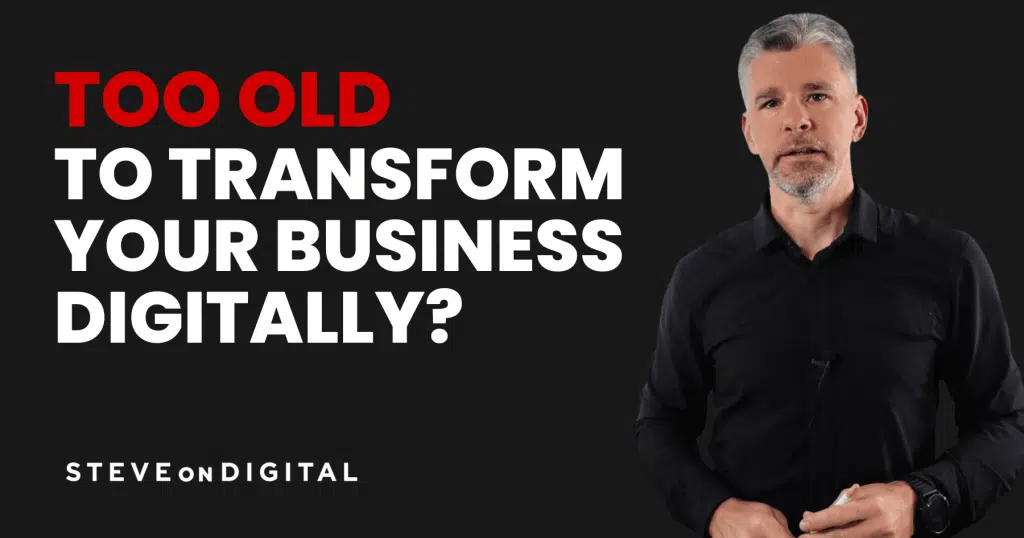
Ever think, “I’m just too old to learn new tech?” Is your solution to rely on younger people who you assume can navigate a digital transformation better than you can, at your age? Yes, I’ll give you that: millennials were born with technology surrounding them. But you have something younger people don’t have: business acumen. So, instead, team up with younger people, both sharing your respective knowledge so that the tech that is implemented responds to the business’s strategic needs. This requires continuous learning and a growth mindset. First of all, the idea that: being “too old” hampers your ability to comprehend and utilize technology is a misconception. It is a limiting belief, as age should never be a barrier to learning or adapting to new tools. Technology is designed to be intuitive and user-friendly, accommodating individuals from all generations. As a virtual CIO, I am a daily witness to entrepreneurs and executives leading successful digital transformations within their organizations. By recognizing that age carries no inherent disadvantage, business professionals can break free from this limiting belief and embrace technology with enthusiasm and curiosity. It’s also crucial to understand that technological advancements are not limited to a particular age group. The pace of innovation is ever-accelerating, and it demands a mindset of lifelong learning. By adopting a growth mindset, you, as a business professional, can actively seek opportunities to expand your technological literacy. There are so many online resources, courses, and workshops readily available to help individuals of all ages enhance their digital skills. Cultivating a culture of continuous learning within the workplace can foster an environment that encourages everyone to explore and adopt new technologies, regardless of their age or experience. Implementing technology successfully in a business context often requires a collaborative effort. Instead of succumbing to the belief that age inhibits understanding, business professionals can leverage intergenerational collaboration as a powerful tool. Younger employees can provide insights into emerging technologies, while seasoned professionals can contribute their industry expertise and critical thinking skills. By fostering a culture of collaboration and knowledge sharing, organizations can tap into the collective strengths of their workforce, bridging the gap between age groups and facilitating the successful integration of technology. The fear of the unknown can be a significant factor contributing to the belief that you are “too old” to understand technology. However, it’s important to recognize that fear is often unfounded and can be overcome. Embracing a trial-and-error approach, asking questions, and exploring technology in a supportive environment can make you more confident in using new applications and also dismantle the belief that age poses a barrier to technological proficiency. The idea that being “too old” to understand technology is a limiting belief that holds no basis in reality. By embracing a growth mindset, cultivating a culture of continuous learning, fostering collaboration, and seeking support, you can overcome this misconception and leverage technology to drive success in your organizations. Age should never be seen as an impediment, but rather as an asset that brings diverse perspectives and experiences to the table. By debunking this myth, you are empowered to embrace the limitless possibilities technology offers, regardless of age. You want to know how to create YOUR IT Roadmap in just a few steps? Get the Infographic: Creating YOUR Digital Roadmap
Skills Of A Successful Digital Leader: Do You Have What It Takes?

Digital leadership skills are crucial for navigating the modern business landscape. A digital leader must possess strategic thinking, innovation, and effective team management abilities. These skills enable leaders to implement digital strategies, manage technological changes, and lead teams successfully. The role of the Chief Digital Officer (CDO) is pivotal in digital leadership within organizations. However, the CDO’s responsibilities can sometimes create a silo effect, isolating digital initiatives from other business operations. In this guide, I will explore the essential skills every digital leader must have. Drawing from my personal experience and industry insights, I’ll provide practical advice on how to excel in digital leadership. Whether you are a small business owner or aspiring leader, this comprehensive guide will help you thrive in the digital age. I’m Steve, a digital transformation expert with a strong background in electrical engineering, an MBA, and a master’s in Project Management. I excel at helping SMEs navigate the digital landscape with practical insights. Let’s begin! Overview of Digital Leadership Digital leadership involves guiding an organization through the complexities of digital transformation, leveraging technology to drive business success. Effective digital leaders are not only tech-savvy but also skilled in strategic thinking, innovation, and team management. A digital transformation leader plays a crucial role in guiding organizations through significant changes, emphasizing essential skills such as inspirational leadership, strategic planning, and the ability to inspire teams toward a digital-first mindset. Importance of Digital Skills for Leaders In the digital age, leaders must possess a diverse set of digital skills. These skills enable them to implement digital strategies, manage technological changes, and lead their teams effectively. According to a study, 70% of new leadership skills are required to manage digital transformation successfully (DigitalDefynd). Successful digital leaders guide teams through digital transformation by fostering autonomy and open communication. Skill Description Strategic Thinking Ability to set and achieve strategic goals in a digital landscape. Innovation Fostering creativity and implementing innovative solutions to challenges. Team Management Building, leading, and motivating effective digital teams. Data Analysis Leveraging data-driven insights for informed decision-making. Communication Clear and effective communication with teams and stakeholders. Adaptability Embracing change and staying current with emerging technologies. Visionary Thinking Transformative Vision A transformative vision in the digital world is crucial for understanding market trends and the necessity for organizations to adapt to continuous changes. Digital leaders must be adept at problem-solving within a digital context. For example, during my tenure, I’ve seen how a clear vision can drive successful initiatives and help businesses adapt to market changes. Forward-Looking Perspective Setting clear objectives and strategies is essential for any digital leader. Developing a digital roadmap helps guide the team towards achieving long-term goals. According to Gartner, 72% of data and analytics leaders are heavily involved in their organization’s digital transformation, emphasizing the need for a strategic approach (Exploding Topics). Technology Understanding Digital Literacy Being literate in digital technologies is vital. This includes understanding how different technologies work and their potential impact on business processes. Past experiences with various technologies enhance a leader’s capability to drive digital initiatives. Adapting to New Technologies Keeping up with emerging technologies is crucial. Integrating new technologies into business processes can significantly improve efficiency and productivity. For instance, 45% of organizations are scaling up their cloud capabilities to support digital transformation efforts (Digital Adoption). Change Orientation Open-Mindedness Embracing change and fostering a growth mindset are critical traits for digital leaders. Encouraging team innovation and adaptability helps navigate the challenges of digital transformation. Effective leaders are those who inspire their teams to embrace new ideas and approaches. Managing Digital Transformation Leading successful digital transformations involves strategic planning and execution. Overcoming common challenges in digital change requires a leader to be proactive and resilient. Despite aligned leadership, 70% of digital transformation projects fall short of their goals, highlighting the need for robust change management strategies (Fit Small Business). The Chief Transformation Officer (CTO) plays a crucial role in driving the digitization of processes, transforming traditional workflows into more efficient digital operations. Leadership Skills Strong Decision-Making Effective decision-making is a cornerstone of successful digital leadership. As a digital leader, I understand the need to make pragmatic and focused decisions that drive the business forward. It’s essential to evaluate all available data, consider the potential outcomes, and choose the best course of action. According to DigitalDefynd, strategic thinking leaders achieve 33% more effective outcomes, highlighting the importance of clear and confident decision-making (DigitalDefynd). Employee engagement and clear communication are vital components of successful digital transformation, ensuring teams are equipped and informed throughout the digital journey. Leading with clarity and confidence instills trust and motivation in your team. When your team understands the decisions being made and the reasons behind them, they are more likely to buy into the vision and work towards common goals. Clear communication of decisions ensures everyone is on the same page, reducing confusion and increasing efficiency. Team Collaboration Building and leading effective digital teams is critical in the digital age. A strong team can achieve great things, especially when they work well together. I’ve found that fostering a culture of collaboration and open communication helps teams tackle complex tasks more effectively. The rise of remote work has increased the importance of strong virtual team management, with remote leadership surging by 80% since early 2020 (DigitalDefynd). Enhancing team communication and cooperation involves implementing tools and practices that facilitate seamless interaction. Digital tools like Slack, Microsoft Teams, and Asana can help streamline communication and project management. Effective leaders use these tools to ensure that team members are always connected and informed, which is essential for maintaining productivity and achieving strategic goals. Tool Purpose Slack Facilitates real-time communication and collaboration among team members. Microsoft Teams Combines chat, video meetings, and file collaboration in one platform. Asana Manages tasks, projects, and workflows for teams. Trello Visualizes project progress using boards and cards. Strategic Thinking Strategic Goals Setting and achieving strategic goals in a digital landscape requires a forward-thinking approach. As a digital leader, I prioritize aligning digital strategies
Why Management Support Is Vital For Digital Transformation Success
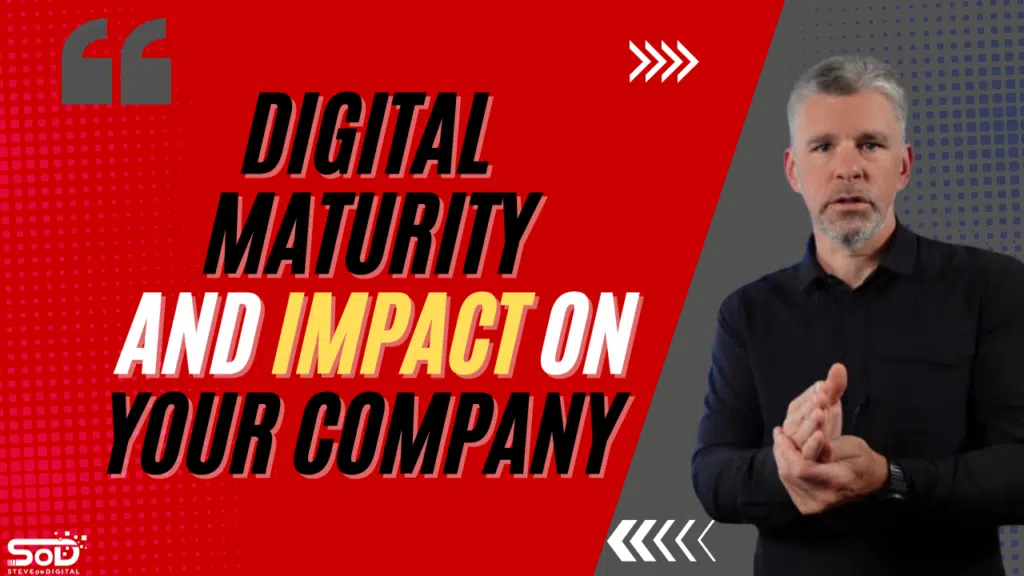
Management support is crucial for successful digital transformation. Without strong leadership backing, even the most well-planned digital transformation initiatives can fail. Management’s involvement ensures that digital technologies are effectively integrated into business processes, aligning with the company’s goals. Digital transformation is not just about technology; it’s about changing how a business operates and delivers value. From setting clear objectives to engaging employees, management plays a key role in driving this change. In my experience, businesses that have strong management support during digital transformation are more likely to achieve their goals and sustain long-term success. I’m Steve, a digital transformation expert with a strong background in electrical engineering, an MBA, and a master’s in Project Management. I excel at helping SMEs navigate the digital landscape with practical insights. Let’s begin! The Role of Management in Digital Transformation Management plays a pivotal role in the success of digital transformation initiatives. From my experience, without strong management support, even the most well-thought-out digital strategy can fail. Management’s involvement is not just necessary; it’s the cornerstone of a successful digital transformation. Importance of Management Support Why is management support so crucial? It’s simple. Management sets the tone for the entire organization. If the management team is fully on board with the digital transformation, it creates a ripple effect throughout the company. Employees are more likely to embrace change when they see that the leadership is committed and invested. Moreover, management support helps in aligning the digital transformation with the overall business strategy, ensuring that every digital initiative contributes to the company’s long-term goals. Statistics back this up. According to a study published in the MIT Sloan Management Review, companies with strong management support for digital transformation are 26% more likely to achieve their digital goals compared to those without such support. This underscores the vital role that management plays in steering the ship during a digital transformation. Management’s Role in Digital Strategy The role of management in digital strategy extends beyond just giving a nod of approval. Management must actively participate in the planning and execution of the digital transformation strategy. This includes setting clear objectives, allocating resources, and ensuring that the digital initiatives align with the company’s business model. I’ve seen companies succeed when their leaders took an active role in digital strategy, from the planning phase to implementation. A successful digital transformation requires management to understand both the potential and the limitations of digital technologies. It’s about making informed decisions that will have a positive impact on the business processes. For instance, during one of my consulting projects, a client’s management team was fully engaged in the digital transformation process, which resulted in a 15% increase in operational efficiency within the first year. This kind of result is only possible when management is actively involved in every step of the digital strategy. Case Study Overview To illustrate the impact of management on digital transformation, let’s look at a real-world example. The Digirati group, as mentioned earlier, is a prime example of a company that has successfully navigated its digital transformation journey thanks to strong management support. In this case, management not only supported the transformation but also drove it by making informed decisions and setting clear business objectives. The result? A significant increase in both revenue and market value, outperforming competitors who invested more in technology but lacked strong management support. This case study clearly shows that management intensity, more than just digital intensity, is the key to a successful transformation. The takeaway here is that without management support, even the best digital technologies will fall short. Understanding Digital Transformation To truly grasp the importance of digital transformation, it’s essential to understand what it entails and why it’s critical for businesses today. What is Digital Transformation? Digital transformation involves integrating digital technologies across every aspect of a business, fundamentally reshaping how the company functions and delivers value to its customers. It’s not just about digitizing existing processes but rethinking and redesigning them to take full advantage of new digital capabilities. This transformation is an ongoing process, not a one-time event, requiring continuous learning and adaptation to stay competitive in the digital age. In my years of working with various businesses, I’ve seen that successful digital transformation requires more than just technology. It demands a shift in mindset across the entire organization. Business leaders must be willing to embrace change and lead by example. This is where management support in digital transformation becomes crucial. Digital Transformation vs. Digitalization It’s important to differentiate between digital transformation and digitalization. Digitalization refers to the process of using digital technologies to change a business model and provide new revenue and value-producing opportunities. Digital transformation, on the other hand, goes beyond digitalization. It involves a cultural change that requires organizations to continually challenge the status quo, experiment, and get comfortable with failure. While digitalization might be the first step, digital transformation is the comprehensive overhaul of a company’s operations and strategy. For example, simply moving paper-based processes online is digitalization. However, when a company rethinks its entire customer experience from the ground up to integrate digital technology at every touchpoint, that’s digital transformation. Common Myths About Digital Transformation There are several misconceptions about digital transformation that I’ve encountered during my work. One of the most common myths is that digital transformation is all about technology. While technology is a significant component, it’s not the only factor. Successful digital transformation also requires a change in company culture, processes, and management support. Another myth is that digital transformation is a one-time project. In reality, it’s an ongoing process that requires continuous innovation and adaptation. Businesses must be prepared to evolve as new technologies emerge and market conditions change. The digital era is constantly evolving, and companies that fail to keep up risk falling behind. Finally, some believe that digital transformation is only for large enterprises. This couldn’t be further from the truth. Small businesses can also benefit greatly from digital transformation by leveraging digital technologies to improve
Guide To Successful Change Management In Digital Transformation | SOD
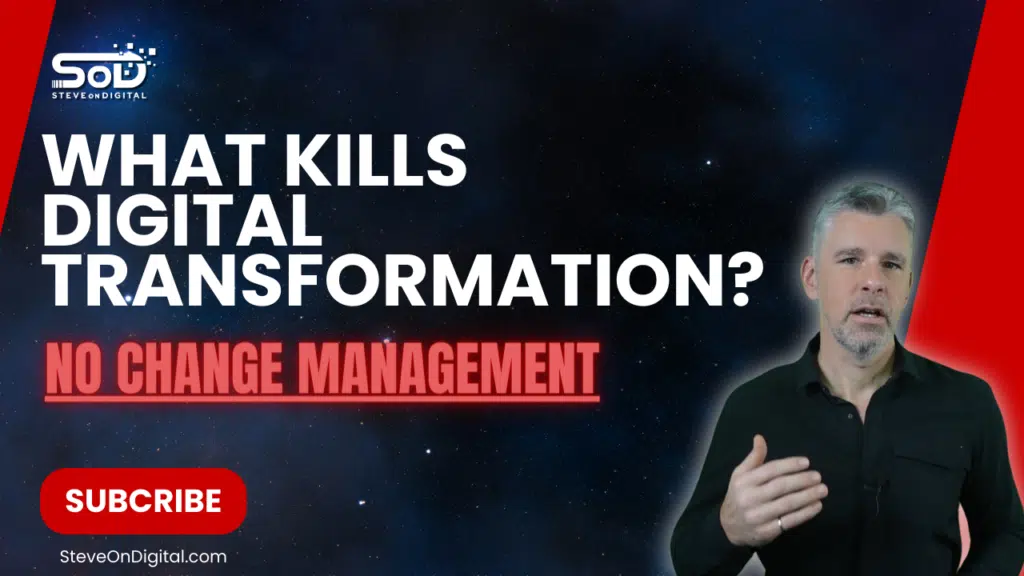
Change management is crucial for the success of any digital transformation. It involves guiding people through organizational changes to ensure smooth implementation and long-term success. Without effective change management, even the best digital transformation initiatives can fail. Digital transformation requires more than just new technology; it demands a shift in how a business operates, its processes, and its culture. By focusing on change management, I can help organizations adapt to new digital tools, overcome resistance, and achieve lasting success in the digital age. I’m Steve, a digital transformation expert with a strong background in electrical engineering, an MBA, and a master’s in Project Management. I excel at helping SMEs navigate the digital landscape with practical insights. Let’s begin! Understanding Digital Transformation Digital transformation is more than just a buzzword; it’s a business imperative. As technology evolves, so too must the way we do business. Digital transformation is the process of incorporating digital technologies across every aspect of a business, leading to significant changes in how the organization functions and delivers value to its customers. But to do this successfully, a structured and systematic approach is essential. The Need for Digital Transformation Let’s face it, the digital era is here, and it’s not waiting for anyone. Companies that fail to embrace digital transformation risk falling behind their competitors. Technological advancements, such as artificial intelligence and cloud computing, are driving businesses to innovate and optimize their operations. Moreover, customer expectations have shifted; they now demand seamless, personalized experiences, which can only be delivered through digital means. This makes digital transformation not just a choice, but a necessity for survival and growth. Key Components of Digital Transformation Digital transformation is a multifaceted process that touches every part of an organization. At its core, it involves adopting new technologies and integrating them into existing business processes. This often requires organizational restructuring, where new business models are developed to better align with the digital tools and strategies being implemented. These changes are not just about technology; they’re about rethinking how your business operates and how you can create more value for your customers. Common Challenges in Digital Transformation Despite its importance, digital transformation is no walk in the park. Many organizations face significant challenges, from resistance to change to technological hurdles. Resistance often stems from fear—fear of the unknown, fear of losing jobs, or simply fear of change itself. Technological challenges, on the other hand, can include anything from integrating new systems with existing ones to ensuring data security in the digital age. These obstacles can derail even the most well-planned digital transformation projects if not addressed properly. The Role of Change Management in Digital Transformation Now, let’s talk about the role of change management in digital transformation. Without a solid change management strategy, even the most promising digital transformation initiatives can fail. Change management is about more than just managing change; it’s about guiding your entire organization through a journey of transformation, ensuring that every employee is on board and that the changes are sustainable. Importance of a Comprehensive Change Management Strategy A comprehensive change management strategy is essential for navigating the complexities of digital transformation. This strategy should include clear communication, continuous support, and a structured approach to managing change. It’s about setting expectations, providing the necessary tools and resources, and ensuring that everyone in the organization understands and embraces the changes. This approach not only helps in achieving a smooth transition but also plays a crucial role in the overall success of the digital transformation. Change Management Versus Project Management It’s important to distinguish between change management and project management, as the two are often confused. While project management focuses on the technical side of implementing new processes and technologies, change management is all about the people. It’s about addressing the human side of change, ensuring that employees understand, accept, and support the new ways of working. Both are essential to digital transformation, but they serve different purposes. Benefits of Effective Change Management Effective change management brings numerous benefits. It increases employee engagement by making them feel involved and valued during the transformation process. This, in turn, leads to higher productivity and better business value. Moreover, a well-executed change management strategy can reduce the risk of failure, ensuring that the transformation is not just a one-time event but an ongoing process that drives continuous improvement and innovation. Developing a Change Management Strategy Creating a successful change management strategy is like plotting a course for a long journey—without a map, you’re bound to get lost. When it comes to digital transformation projects, this strategy becomes your guiding star. I’ve learned firsthand that having a clear plan not only helps to navigate through the complexities but also ensures everyone is on the same page. It’s about setting clear objectives, assessing readiness, and making sure leadership is actively engaged. Setting Clear Objectives and Vision When embarking on a digital transformation, the first step is to set clear objectives and a compelling vision. This isn’t just about where you want to go, but why you’re going there. From my experience, a clear vision acts as the anchor for the entire process. It aligns the team and keeps everyone focused on the end goal. In practical terms, this means defining what success looks like—whether it’s improving key performance indicators (KPIs), enhancing customer experiences, or streamlining business processes. These objectives should be specific, measurable, and tied directly to the overall business strategy. Assessing Organizational Readiness Before diving into any transformation, I always make it a point to assess the organization’s readiness. This involves taking a close look at the existing business processes and the current company culture. Are your processes outdated, or can they be easily adapted to new technologies? Is your company culture open to change, or are you likely to face resistance? Understanding where you stand is crucial for identifying potential roadblocks early on. This assessment isn’t just a one-time check; it’s an ongoing process that should be revisited as the transformation progresses.

